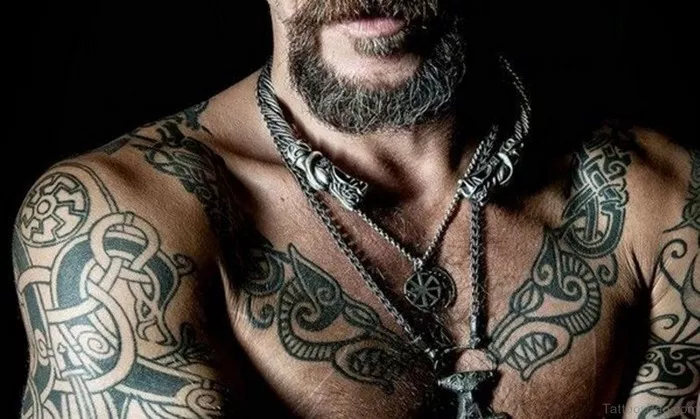In the realm of body art, tattoos serve as powerful symbols of identity, heritage, and personal expression. Among the vast array of tattoo styles, Celtic and Viking designs stand out for their rich cultural significance and intricate aesthetics. While both are rooted in ancient European history, they represent distinct cultural traditions with unique visual elements and symbolic meanings. Understanding the nuances between Celtic and Viking tattoos requires delving into the history, symbolism, and artistic motifs of these ancient civilizations.
Cultural Origins and Historical Context
To comprehend the disparity between Celtic and Viking tattoos, one must first grasp the cultural and historical contexts that gave rise to these distinct artistic traditions.
The Celts, an ancient group of Indo-European tribes, inhabited vast regions of Europe during the Iron Age, from the British Isles to parts of Central Europe. Renowned for their intricate artwork, spiritual beliefs, and warrior culture, the Celts left an indelible mark on European history. Celtic art, characterized by interwoven patterns, zoomorphic designs, and spirals, reflects their deep connection to nature and their reverence for the divine.
In contrast, the Vikings were seafaring Norse warriors and explorers who originated from what is now modern-day Scandinavia. From the late 8th to the 11th centuries, they embarked on daring voyages across Europe, the North Atlantic, and even reached as far as North America. Famed for their martial prowess, maritime prowess, and mythological beliefs, the Vikings left an enduring legacy that continues to captivate imaginations today.
Symbolism and Iconography
Central to both Celtic and Viking tattoos is the intricate symbolism embedded within their designs. However, the symbolism associated with each tradition reflects the distinct values, beliefs, and cultural narratives of their respective societies.
Celtic tattoos often feature intricate knots, spirals, and zoomorphic motifs, such as animals and mythical creatures like dragons and serpents. These symbols are imbued with profound meanings, representing concepts such as eternity, interconnectedness, and spiritual growth. The Celtic cross, adorned with intricate interlace patterns, symbolizes the fusion of Christian and pagan beliefs, embodying the synthesis of spiritual traditions.
In contrast, Viking tattoos draw inspiration from Norse mythology, legendary sagas, and Viking symbolism. Iconic Viking symbols include the Valknut, a symbol associated with the Norse god Odin and often interpreted as representing the interconnectedness of life, death, and fate. The Helm of Awe, or Ægishjálmr, is another potent Viking symbol believed to confer protection and courage upon its wearer. Other popular Viking motifs include depictions of mythical creatures like dragons, wolves, and ravens, which feature prominently in Norse mythology.
Aesthetic Differences and Artistic Styles
Beyond symbolism, the aesthetic styles of Celtic and Viking tattoos also diverge, reflecting the distinct artistic sensibilities and cultural influences of each tradition.
Celtic tattoos are renowned for their intricate knotwork, geometric patterns, and flowing curves. These designs often evoke a sense of rhythm and movement, with interlaced lines creating mesmerizing visual effects. Celtic knotwork, characterized by its seamless interweaving of lines, symbolizes the eternal cycle of life, death, and rebirth. Other common motifs in Celtic tattooing include spirals, triskelions, and animal forms rendered in a stylized, decorative manner.
Viking tattoos, on the other hand, tend to feature bolder lines, sharper angles, and a more aggressive aesthetic. Viking art is characterized by its bold, powerful imagery, reflecting the martial ethos of Norse society. Viking tattoos often depict fierce warriors, fearsome beasts, and symbols of strength and protection. The use of runes, ancient Norse writing systems, is also prevalent in Viking tattoo designs, adding an element of mystique and authenticity.
Cultural Significance and Personal Meaning
Ultimately, the difference between Celtic and Viking tattoos extends beyond mere aesthetic considerations; it encompasses the cultural significance and personal meanings attached to these ancient symbols.
For many individuals, Celtic tattoos serve as a potent expression of their Irish, Scottish, Welsh, or Breton heritage. These tattoos may commemorate ancestral roots, celebrate cultural identity, or serve as talismans of protection and good fortune. Celtic symbols are also prized for their universal appeal, transcending cultural boundaries to resonate with people of diverse backgrounds.
Similarly, Viking tattoos hold profound significance for those drawn to Norse mythology and Scandinavian heritage. Whether paying homage to legendary figures like Odin, Thor, and Freya or invoking the warrior spirit of the Viking Age, these tattoos serve as tangible links to a rich tapestry of history and legend. For some, Viking tattoos may symbolize bravery, resilience, and the pursuit of adventure, reflecting the indomitable spirit of the Norse explorers who once ruled the seas.
Conclusion
In summary, the disparity between Celtic and Viking tattoos lies not only in their visual aesthetics but also in the cultural narratives, symbolism, and personal meanings they embody. While Celtic tattoos evoke the mystique of ancient Celtic civilization with their intricate knotwork and spiritual symbolism, Viking tattoos channel the ferocity and valor of Norse warriors through bold imagery and mythological motifs.
Yet, despite their differences, both Celtic and Viking tattoos share a common thread: a reverence for the past and a desire to connect with the rich tapestry of human history. Whether adorned with Celtic knots or Viking runes, these tattoos serve as reminders of our shared heritage and the enduring power of ancient symbols to inspire, empower, and captivate the human imagination.

